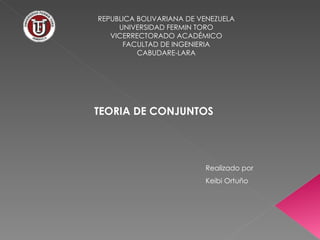Teoria conjuntos
•Descargar como PPT, PDF•
0 recomendaciones•1,104 vistas
Denunciar
Compartir
Denunciar
Compartir

Más contenido relacionado
La actualidad más candente
La actualidad más candente (16)
Similar a Teoria conjuntos
Similar a Teoria conjuntos (20)
Teoria conjuntos
- 1. REPUBLICA BOLIVARIANA DE VENEZUELA UNIVERSIDAD FERMIN TORO VICERRECTORADO ACADÉMICO FACULTAD DE INGENIERIA CABUDARE-LARA TEORIA DE CONJUNTOS Realizado por Keibi Ortuño
- 9. 4- Leyes Distributivas A U (B I C) = (A U B) I (B U C) I (B U C) A I (B U C) = (A I B) U (B I C) 5-Leyes de Identidad A U 0 = A A I 0 = 0 6- Leyes de Dominación A U U = U A I U = A 7- Leyes de Complementación A U C(A) = U C (C(A)) = A A I C(A) =0 C(U)=0 C(0)= U 8-Leyes de De Morgan C(A U B) = C(A) I C (B) C(A I B) = C(A) U C (B)
- 12. Sea A un conjunto finito. Se dice que: i. El cardinal de A es 0 si A =0. ii. El cardinal de A es n y lo denotaremos por #A = n si A tiene n elementos. Teoremas Sean A yB dos conjuntos finitos, luego: i. B - A) = #B - #(AI B) ii. #(AUB) = #A + #B - #(AI B) Si A B y C son tres conjuntos finitos entonces #(AUBUC) = #A + #B +#C - #(AI B) - #(AI C) - #(BI C) + #(AI BI C).
